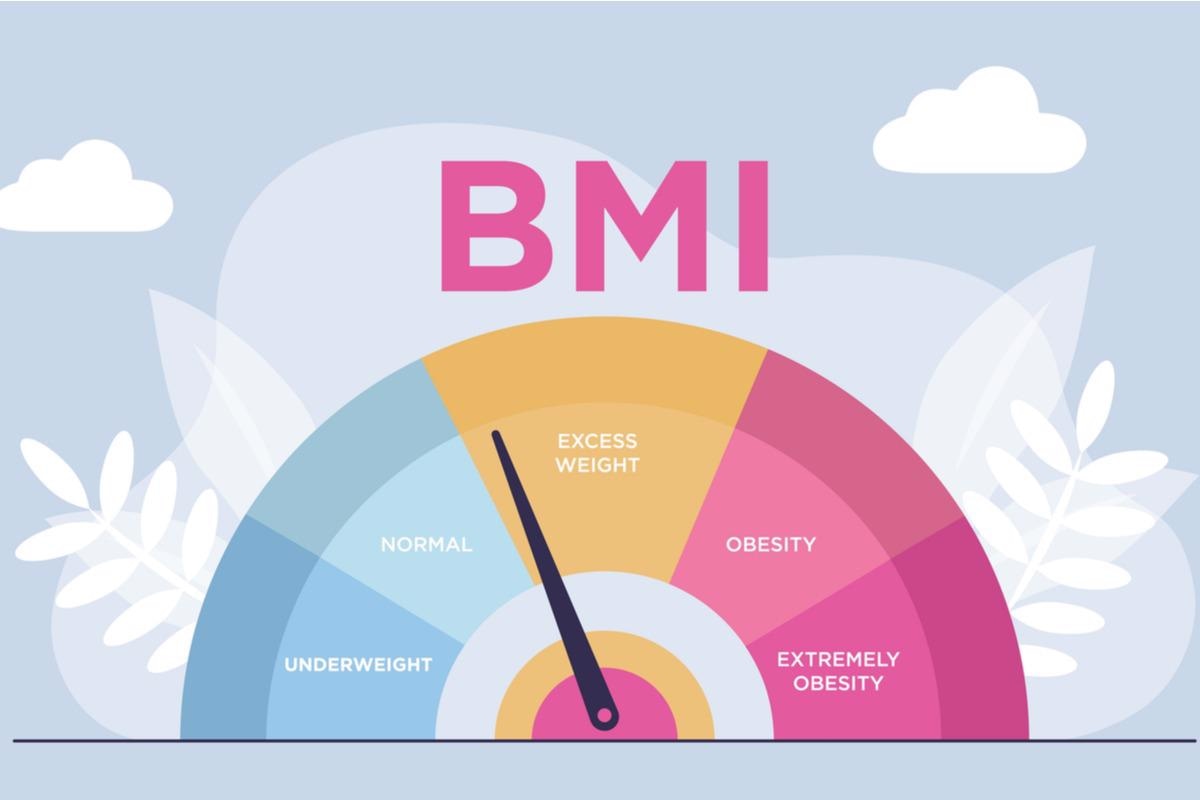Introduction
The role of BMI
Earlier measures
The rise of BMI
Non-gaussian BMI distribution
Problems with terminology
Non-generalizability
Ignores visceral fat
Ignores non-obesity risk factors
Alternative measures
Waist circumference
Trefethan’s formula
Conclusion
References
Further reading
Obesity and malnutrition represent two opposite ends of the body mass spectrum. To understand both, definitions are important, as well as the genetic and environmental contributions to these conditions and the identification and monitoring of associated comorbidities.

Image Credit: TonzTonz/Shutterstock.com
The role of BMI
The body mass index (BMI) is possibly the best-known body weight index. It is unquestionably the most extensively used to measure overweight and obesity. The BMI represents the calculated relative weight for height, calculated as weight in kg/(height in m)2. This allows for BMI to be used across populations with varying heights.
The World Health Organization (WHO) classifies weight in relation to the risk of other health conditions and death due to obesity, putting adults into four categories from underweight to very severe obesity, with a BMI of <18.5 to ≥40.0, respectively. This has been of clinical use to counsel adults regarding their desired weight goals.
However, the importance of defining fatness is obvious from the social stigma as well as the medical importance of this term. Discrimination with the resulting emotional harm begins from childhood onward. This is severe enough and widespread enough that fat people cannot dream of entering certain, by no means a few, careers.
Not only so, but the resulting internalization of these societal values also makes the fat people think of themselves as lesser, unable to express their genuine talents and achieve their true potential. Many find it difficult to find or marry people who are not obese themselves due to their perceived laziness, indiscipline, and other unattractive traits, besides their supposed lack of physical appeal.
Earlier measures
Body build is also a poorly defined entity related to the actual functional consequences of fat mass. For this reason, early on, insurers, who were primarily concerned with the observed inverse association between body weight and life expectancy, except in an ideal range, looked at weight-for-height tables based on gender and age. Based on over four million adults, these tables were used for population-based reference tables, though the subjects were mostly white males.
The desirable weight for height showed an increase over the decades from 1960 to 1980 but always remained lower than the mean height for the population. The body build index also failed to reflect that tall people always had a lower mortality rate than short people despite identical weight-height ratios. The height, limb length, and bone mass all contributed to the significance of this measure.
Taller people tended to have a narrower build, which meant short people could not simply be treated as scaled-down versions of the former. This put paid to efforts to use a mathematical 3-D volume to represent the mass in terms of the cube root of weight divided by height (3√Wt/Ht) or weight/height.
Later equations using Weight/Height1.6 were the most scalable, indicating the exponential effect of increasing height but the linear effect of increasing weight on this ratio. Thus, tall people will have a lower measure with this ratio than the weight/height ratio.
The rise of BMI
Finally, scientists adopted the weight/height2 ratio for convenience. This is called the Quetelet Index, named after the father of statisticians, Lambert Adolphe Jacque Quetelet.
He developed the concept of social averages to try and determine what an average person was like – the first time that distribution mathematics was applied to human characteristics. He observed that the body mass to height relationship in normal young adults remained relatively constant when using this ratio compared to either weight/height or weight/height3.
This was then called the body mass index (BMI) in 1972 by physiologist Ancel Keys, who began to use it to represent the distribution of body mass over a population with the least variance due to height. In the early 1900s, the WHO adopted the BMI-based classification of body weight for height, and it began to be used worldwide.
In fact, BMI was found to be the determinant of convenience in the Western world, providing a standard epidemiological classification of body weight for height.
Around 1995, the National Institutes of Health (NIH) in the USA determined that men and women with a BMI of 27.8 and 27.3 or more, respectively, were overweight, while below this, the BMI was termed normal. The basis was the BMI, below which 85% of people fell, in the National Health and Nutrition Examination Study (NHANES).

Image Credit: Dragana Gordic/Shutterstock.com
Three years later, the cutoff was reduced to 25, based on the WHO grading. Instantaneously, millions of obese people were added to the American population. This led to the perception and documentation of rising obesity rates in America, to the point that half or more of the adult population today is designated overweight or obese, despite making up a large part of the normal BMI distribution.
Non-gaussian BMI distribution
The distribution of BMI in American adults has always been on the higher side of the median. The explanation is the severe morbidity and mortality associated with a very marked reduction in BMI, since both lean and fat mass will be too low to be compatible with life in this case. This usually happens in severely malnourished or cachectic patients. Conversely, a markedly higher BMI is still unhealthy but is mostly associated with chronic disease, leading to a long-term decrease in life expectancy.
As published in 1995, the four WHO categories indicate that all those with a BMI of 25 or more are over the “desirable weight.” This was adopted by almost all classification systems, but unfortunately, the population reference data on which this was based has not been duplicated in any other studies.
Problems with terminology
Obesity itself is being redefined, with BMI in the range of 25 to 30 being termed “pre-obesity.” Beyond that, at intervals of 5 each, BMI values fall into class I, class II and class III obesity. However, it is not sure that a person with pre-obesity is in the process of becoming obese. Moreover, it is commonly observed that people who are initially slim but become obese later would first have to become pre-obese, according to this classification.
As one researcher asked, “By analogy, should those classified as “underweight” now be referred to as being “prenormal”?” However, the BMI does not reflect other risk factors also associated with body weight, such as the distribution of fat over the body. For instance, central or visceral fat mass is associated with a higher risk to health than fat elsewhere. Especially, it ignores the possibility that a person with a very high BMI could have a very low fat mass and the converse.
Non-generalizability
A major problem with the BMI goes largely unmentioned. The basis for this measurement is a largely White American male population – which means it is difficult to extrapolate to men of other races, women, and children.
Some researchers have established that body fat could range from 10% to 32% in men with the same BMI of 27. Interestingly, the NIH suggests that men with 25% or more of their body mass composed of fat are obese, vs. 35% or more for women.
Yet, in men and women with a “normal” BMI of 25 or more, the percentage of body fat fell between 14% and 35%, vs. 26% and 43%, respectively. Thus, low-normal to obese fat values were observed in these groups, despite the normal BMI. Moreover, the BMI does not reflect the differences between men and women regarding normal fat mass.
Another consideration is the documented increase in height as well as weight in Western populations over the last century. In Europe, for instance, those in the Northern nations were ~5 feet 3 inches in the 17th century, while at present, it is nearer 6 feet. This is associated with a rise in mean BMI.
Thus, obesity should be determined not simply on the basis of a BMI of 30 or more. In fact, the BMI reflects lean mass better than fat mass, at least in men.
Ignores visceral fat
The build-up of fat in the abdominal region rather than around the hips and thighs is observed to be a risk factor for cardiovascular disease, diabetes, gallbladder stones, and gout. Thus, the abdominal circumference, or the abdominal-to-hip circumference ratio, is more meaningful as a predictive factor for these conditions in both men and women.
Fatty liver and the accumulation of fat in the skeletal muscle are best linked to abdominal or visceral fat deposition and may be considered a reflection of the disease process that results from abnormally high fat mass and insulin resistance. Interestingly, the BMI would not be able to differentiate the presence of significant masses of fat in these organs, and total body fat mass is also a poor predictor of fat at such locations.
In diabetics, the BMI is higher than in non-diabetics at the same age, but the lean mass percentage remains very similar in both groups.
Ignores non-obesity risk factors
Finally, the BMI does not recognize the strong genetic and familial component of fat accumulation in different parts of the body, nor the total fat mass. Older people also have more body fat, in general, than younger people with similar BMI.
The correlation of BMI with mortality risks should always consider family histories of relevant metabolic disorders, including diabetes, metabolic syndrome, dyslipidemias, cancers, hypertension, and cardiovascular disease. With the latter, it is now known that fully half of the risk comes from gene variants rather than from environmental factors, including obesity.
Smoking, excessive drinking, mental illness, and chronic obesity are also important factors in tracing a correlation between BMI and illness or death. Occupational factors as well as the fat deposition incidental to the use of certain medications, also have a bearing on the BMI.
Studies that do not consider these factors may not draw valid inferences about the association between BMI and mortality risk, especially in relation to cardiovascular disease. First, a significant minority of people termed obese because of their BMI have no cardiovascular risk factors. They may be termed to have “metabolically healthy obesity (MHO).” Secondly, once known risk factors are adjusted for, BMI is no longer a risk factor by itself for cardiovascular events.
The ongoing EPIC observational study is one of many that has found that “overweight” people have the lowest risk of death, with a BMI above 30 or below 21 only showing any increase in mortality risk. The rest of the BMI spectrum appears to have a stable risk over the 10-year period of observation.
Alternative measures
To assess the percentage of body fat mass and its accumulation in different spots, indirect methods are available, such as bioelectrical impedance, underwater weighing, density determination, and isotope-labeled water mass. Skin-fold thickness is a direct method of measuring fat mass.
Dual-energy x-ray absorptiometry (DEXA) scans build a 3-D image of the density of the body organs and the location of fat mass. Modified forms of computed tomography (CT) that involve little radiation exposure are also used, and magnetic resonance imaging (MRI) is a potential, though very expensive, candidate.
Waist circumference
Many studies have shown that the waist circumference-to-BMI ratio was correlated with the greatest increase in the risk of death. Alternatively, the National Heart, Lung, and Blood Institute (NHLBI) suggest using three measures to assess the health risks and the weight of an individual, namely, the BMI, waist circumference, and risk factors for any conditions related to obesity.

Image Credit: Prostock-studio/Shutterstock.com
Some studies demonstrate that a high waist circumference explains the increased risk for type 2 diabetes in the USA compared to the UK, rather than the BMI. Again, the risk of death at any given BMI increases by 17% and 13% per 5 cm increase in waist circumference. This lends urgency to the task of standardizing the protocol for waist circumference measurements to ensure comparability between studies. Reassuringly, available evidence suggests that by either the NIH or WHO protocol, the estimates of obesity prevalence appear similar, though different between men and women.
Similarly, the reliability of self- or technician-measured waist circumference should be evaluated further, though current evidence suggests good agreement between the two. Ethnic differences in the risk threshold for waist circumference must also be defined by prospective studies for each BMI category. These methods are better than the BMI to determine fat mass. Moreover, researchers say, “It now is generally accepted that a relationship between BMI and mortality risk should be applied only to large populations. It should not be applied to an individual in an unqualified fashion. A segment of the population is now considered to be “fat” by any criteria but “fit” and not at risk for early mortality.”
Trefethan’s formula
Oxford mathematician Nick Trefethen believes that using weight/height2.5 would provide a better measure of relative body mass compared to the BMI. And even apart from the obsession with body fat mass, many experts think that diagnostic tests such as an electrocardiogram, blood sugar, blood lipids, and blood pressure would provide a better-rounded picture of overall health.
Conclusion
In conclusion, it may safely be said that most people with a BMI in the “overweight” or “pre-obese” category are not at higher risk for disease and death compared to those with “normal” or “underweight” BMI. Novel measurements such as the Trefethen Index, or established ones such as the waist circumference, can be tested using the massive amounts of data available from earlier long-term prospective studies for their correlation with health risks over time.
Obesity researcher Dr. Ahima of the Perelman School of Medicine at the University of Pennsylvania said, “There is an urgent need for accurate, practical and affordable tools to better predict the risks of diseases and mortality. Advances to improve the measurement of obesity and related factors will help determine the optimal weight for an individual, taking into account factors such as age, sex, genetics, fitness, pre-existing diseases, as well novel blood markers and metabolic parameters altered by obesity.”
References
- Nuttall, F. (2015). Body Mass Index: Obesity, BMI, and Health: A Critical Review. Nutrition Today. doi: 10.1097/NT.0000000000000092. https://journals.lww.com/nutritiontodayonline/fulltext/2015/05000/body_mass_index__obesity,_bmi,_and_health__a.5.aspx
- Why Use BMI? https://www.hsph.harvard.edu/obesity-prevention-source/obesity-definition/obesity-definition-full-story/
- Ross, R. et al. (2020). Waist Circumference as A Vital Sign in Clinical Practice: A Consensus Statement from The IAS And ICCR Working Group on Visceral Obesity. Nature Reviews Endocrinology. https://doi.org/10.1038/s41574-019-0310-7. https://www.nature.com/articles/s41574-019-0310-7
- Balkau, B. et al. (2007). International Day For The Evaluation Of Abdominal Obesity (IDEA): A Study Of Waist Circumference, Cardiovascular Disease, And Diabetes Mellitus In 168,000 Primary Care Patients In 63 Countries. Circulation. doi: 10.1161/CIRCULATIONAHA.106.676379. https://pubmed.ncbi.nlm.nih.gov/17965405/
- Blackburn, H. et al. (2014). Commentary: Origins and Evolution of Body Mass Index (BMI): Continuing Saga. International Journal of Epidemiology. https://doi.org/10.1093/ije/dyu061. https://academic.oup.com/ije/article/43/3/665/2949550
- BMI Not Accurate Enough: Obesity/Mortality Paradox Demonstrates Urgent Need for More Refined Metabolic Measures. https://www.sciencedaily.com/releases/2013/08/130822141948.htm
Further Reading
- All Obesity Content
- What is Obesity?
- Causes of Obesity and Overweight
- Obesity, What Can be Done?
- What is Body Mass Index (BMI)?
Last Updated: May 31, 2022

Written by
Dr. Liji Thomas
Dr. Liji Thomas is an OB-GYN, who graduated from the Government Medical College, University of Calicut, Kerala, in 2001. Liji practiced as a full-time consultant in obstetrics/gynecology in a private hospital for a few years following her graduation. She has counseled hundreds of patients facing issues from pregnancy-related problems and infertility, and has been in charge of over 2,000 deliveries, striving always to achieve a normal delivery rather than operative.
Source: Read Full Article
